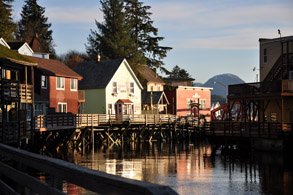How to Become a Certified Local Government
The Office of History and Archaeology (OHA) administers the Certified Local Government (CLG) program in Alaska. OHA assists local governments as they develop their preservation program. To become certified, a local government must meet all the requirements found in 36 CFR 61 and the Alaska CLG Program Guidelines established by the Alaska State Historic Preservation Office. As a CLG your community can help create an effective preservation partnership of local, tribal, state, and federal governments.
Certification Process
If your community is interested in becoming a CLG, it needs to enact a historic preservation ordinance that establishes a professional historic preservation commission, adheres to applicable state and federal preservation laws, has an inventory compatible with the Alaska Heritage Resources Survey (AHRS), and follows Alaska's Open Meetings Law. OHA can assist in the development of your preservation ordinance.

After adoption of the ordinance, the local government should appoint the members of the historic preservation commission including an archaeologist, architect and historian that meet the qualifications outlined in the Secretary of the Interior's Professional Qualification Standards. A local government can be certified without filling all the professional seats if a good faith effort has been made to fill them. OHA in partnership with LGA has developed an Orientation Manual for Alaska's Municipal Historic Preservation Commissions.
After these steps are completed, your local government will submit an application with a copy of the historic preservation ordinance, copies of resumes for commissioners that occupy professional seats (or a letter from the elected official stating why professional seats were not filled), and a copy of the community's historic preservation plan, if one is completed. After review of the application OHA will send a Certification Agreement to the local government. After the agreement is signed, OHA will forward the application package to the National Park Service for final approval. More detailed information and the application for certification can be found in the Alaska CLG Program Guidelines.
To become a CLG you must have a:
- Historic preservation ordinance
- Historic preservation commission
- Process for inventorying historic and archaeological resources
- Procedure for reviewing nominations to the National Register of Historic Places
- Procedure for reviewing local projects for impacts on historic resources
- Process for local historic preservation planning and, at a minimum, a draft plan
- Process for public participation
After Certification
Once a local government is certified, it joins a network of preservation minded national, state, tribal and local governments. Expertise and resources are shared to further the preservation of important resources in Alaska especially when important places will be listed in the National Register of Historic Places and when federal agencies may impact historic properties under a government's jurisdiction.
As part of the certification agreement, local governments will be asked to submit an annual report to OHA. The annual report form provides information about the commission's activities during the past calendar year.
OHA regularly communicates with all certified local governments. OHA will provide training at the request of local commissions when possible and assist them as they work to protect their important cultural assets. OHA also will review historic preservation programs to help local governments improve their programs and recommend areas for growth.
Historic Preservation Fund CLG grants are available annually. Ten percent of the Historic Preservation Fund allocation to the State Historic Preservation Office is for CLG grants. These are competitively awarded to assist local governments in the identification, evaluation, and protection of historic properties.
